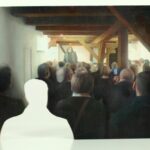
Petroff Rodion
Rodion Petrov’s work represents the hyperrealistic (also called superrealistic, photorealistic) direction of painting, which is not very actively exploited in our country. Among the authors worth mentioning are Algimantas Švėgžda, perhaps Žygimantas Augustinas, and a few others. In the works of these authors, one enjoys the plastic mastery and the suggestiveness of the reality of the image of objects (subjects).
However, R. Petrov follows the paths of world creators more, and as is usual for representatives of this direction, for the plots of his work he uses the world created by mass media – photography, commercial advertising, television, etc. – according to which he creates his own, but already “retold”, non-existent world.
In fact, by creating a convincing illusory reality, hyperrealists question the issue of the balance between reality and the artificial world. Thus, reality is simply eliminated in their works, or, according to Jean Baudrillard, something that never existed in reality is simulated. The goal is to shock the viewer, to cause him surprise or distrust of the visible image. After all, before our eyes is not photography, but the traditional technique of oil on canvas. A moment of movement suspended in time allows us to doubt our senses, and only the enlarged scale of the work indicates visual self-deception.
This illusionistic game with the viewer is the essence of R. Petrov’s work, since the artist believes that if there is no idea in the work, the exact photographic reproduction of the image simply kills the artist’s individuality. In this sense, R. Petrov is close to the essence of conceptualism – the idea of a work of art that elevates it above plastic expression.
This is also evidenced by compositions such as “Only the best wishes”. An ambiguous “portrait” of thought invites the viewer to find the correct answer. Today’s screen culture, in which thinking is a spontaneous reaction to an image or, according to art critic Odeta Žukauskienė, seeing replaces perception¹, is a great niche for an indirect discussion between the artist and the viewer. The artist rolls the dice, and the viewer must continue the game by moving the figure to the appropriate field of perception.
Arguing that contemporary art is often too serious, the author often uses irony, mocking the heroes or “sanctuary” of contemporary society and the environment. However, do not relax! The seemingly witty surface of a work of art hides a relevant context, which, when “read”, decodes the deep idea of the work.
Often, an object/subject dominates the works (such as the McDonald’s clown, plastic oil and olive oil bottles, garbage bags, a brush-tongue, etc.). There is no surrounding environment – objects or figures are simply placed on a white background. Additional information about place and time is not necessary. The necessary insights are dictated by the depicted object itself.
We can observe this combination of experiences in this exhibition, where works that are quite different in nature are presented – from hyperrealistic social criticism (a series dedicated to the fast food chain McDonald’s (works “Trash Bags”, “Completely New”, “Rebranding. WC Public”, etc.) or the composition “Oil on Canvas”, etc.) to the painting “Lucia’s Self-Portrait”) or topical issues of Lithuanian art (“Public Opinion”). All of them, in one way or another, try to talk about the establishment of the label (“brand”) phenomenon in our society. In this way, the artist significantly responds to the essence of postmodern culture – to use artistic means to directly respond to environmental phenomena, mock the habits of a consumer society, or adapt old truths to the present (such as a diptych based on Edouard Manet and Kuzma Petrov-Vodkin or the pink canvas “Seroburomalinovaya” echoing the spirit of Mark Rothko).


